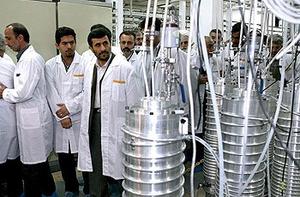IranIran installs faster centrifuges at Natanz
Iranian officials said Wednesday that Iran has begun installing more sophisticated enrichment centrifuges at its Natanz uranium enrichment facility. Speeding up the enrichment process would shorten Iran’s “break out” period: if Iran were to inform the IAEA that it was withdrawing from the nonproliferation treaty (NPT), a step which would allow it to build nuclear bombs without violating the treaty – the time between withdrawal from the treaty and to first nuclear weapons being build will be that much shorter. This will make it that much more difficult for outside powers to intervene to stop the build-up.

Iranian president Ahmadinejad inspecting enrichment centrifuges // Source: tinmoi.vn
Iranian officials said Wednesday that Iran has begun installing more sophisticated enrichment centrifuges at its Natanz uranium enrichment facility. The announcement was made as Iran and the P5+1 group are getting set to renew their discussions of Iran’s nuclear status.
The New York Times reports that Fereydoon Abbasi, the head of Iran’s Atomic Energy Agency, was quoted by the semiofficial Iranian Students’ News Agency as saying that Iran began putting in the new centrifuges last month. “We have produced the machines as planned, and we are carrying out the installation gradually, to complete the tests relevant to the new generation,” he said.
Iran informed the International Atomic Energy Agency (IAEA) late last month that it would be installing the new equipment at Natanz in order to speed up the production of enriched uranium.
Speeding up the enrichment process would shorten Iran’s “break out” period: if Iran were to inform the IAEA that it was withdrawing from the nonproliferation treaty (NPT), a step which would allow it to build nuclear bombs without violating the treaty – the time between withdrawal from the treaty and to first nuclear weapons being built will be that much shorter. This will make it that much more difficult for outside powers to intervene to stop the build-up.
The Times notes, though, that another Iranian news agency, Fars, quoted Abbasi as saying that the new centrifuges were designed to enrich uranium to a purity of less than 5 percent, not to the 20 percent level – the level from enrichment to weapon-grade material is short.
Separately, Iran announced on Tuesday that it was converting some of its stockpile of 20-percent enriched uranium into reactor fuel. IAEA officials say once the uranium is converted, it is difficult to reconvert it for weapons.
